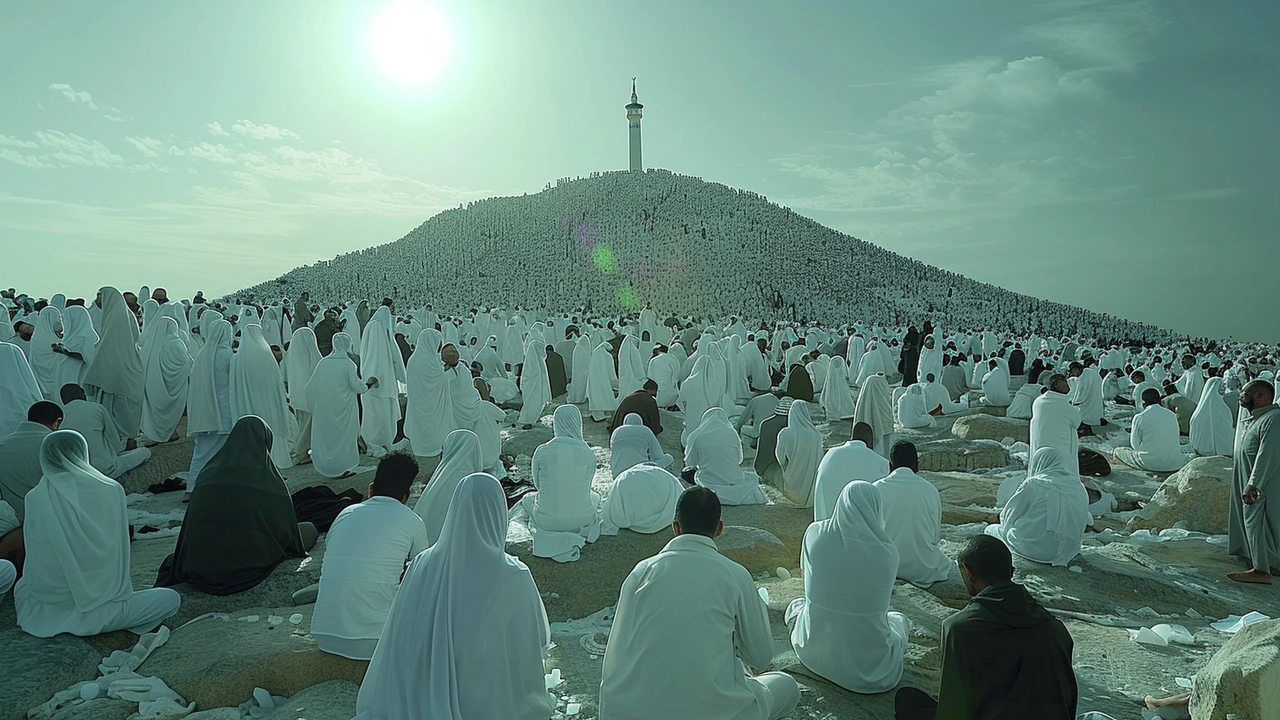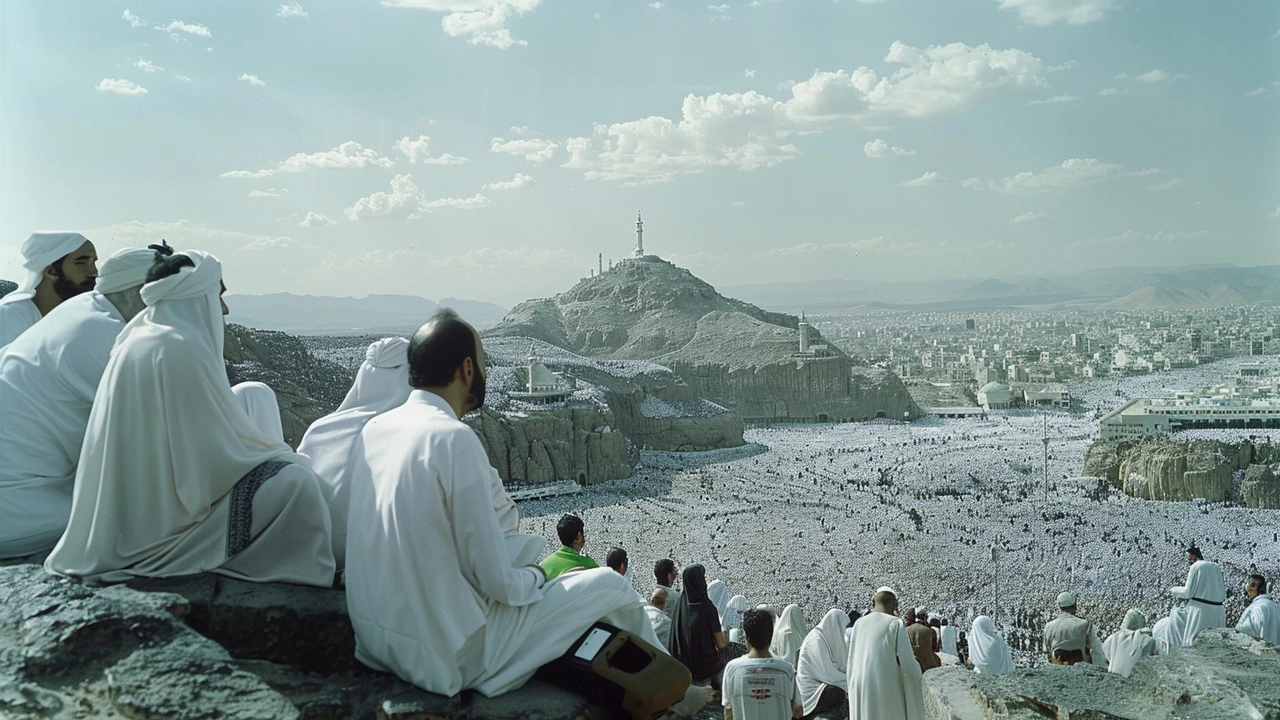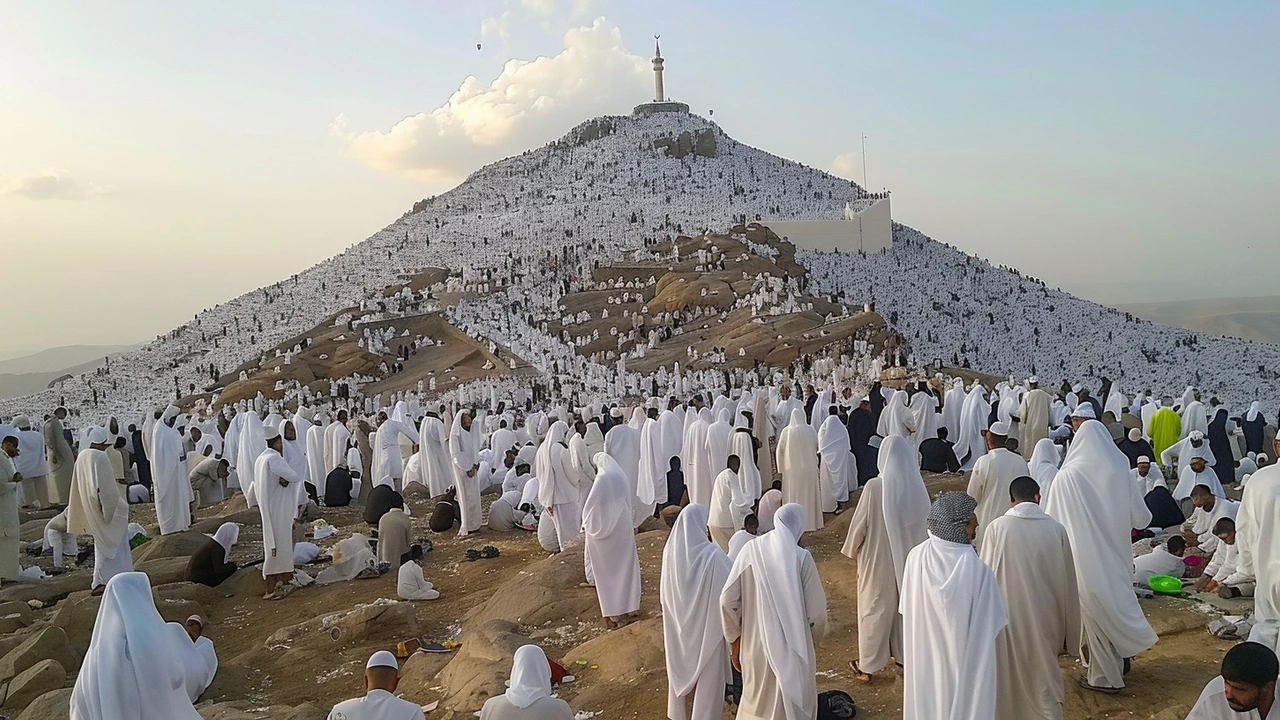Pilgrims Converge on Mount Arafat
Muslims from various corners of the world have come together at Mount Arafat, which is located near Mecca in Saudi Arabia, to observe the holiest day of the annual Hajj pilgrimage. This sacred ritual, known as the day of Arafat, is a momentous occasion for those participating in the pilgrimage, as they stand on the rocky slopes of Mount Arafat and the surrounding plains, beseeching God for mercy, blessings, prosperity, and good health. The day is deeply significant in Islam and is a time of intense supplication and reflection.
Thousands of devoted pilgrims made their way to the mount, which is situated about 20 kilometers southeast of Mecca, navigating through the early morning darkness. As the first light of dawn touched the ground, the pilgrims, dressed in simple white garments known as ihram, gathered on the plain. Their hands were raised in prayer, and many were overcome with emotion. The terrain of Mount Arafat is known as the 'hill of mercy' and holds incredible spiritual importance.
The Spiritual Significance of Mount Arafat
Egyptian pilgrim Hussein Mohammed described the experience as 'the best day for Muslims during the year, and the best feeling that anyone can experience.' This sentiment is shared by the millions who take part in the Hajj pilgrimage each year. The belief is that on this day, if performed correctly and with true intent, one's past sins are forgiven. The prophet Muhammad delivered his final sermon, known as the Farewell Sermon, from Mount Arafat approximately 1,435 years ago. In this sermon, he called for equality, unity, and justice among all Muslims, principles that remain integral to the faith today.
The sermon addressed key issues such as the sanctity of life, the importance of family, and the need for fairness and piety. Many consider these teachings to be the cornerstone of Muslim civilizational values. The echo of Muhammad's words from centuries ago reverberates through the hearts of those present on Mount Arafat, forming a powerful connection to their faith's history.

The Journey to Mecca and Mina
This year's Hajj officially began on Friday, as pilgrims transitioned from the Grand Mosque in Mecca to Mina, a desert plain just outside Mecca. This journey marks the start of several days of rituals, including the powerful day of Arafat, followed by the symbolic stoning of the devil at Mina and the celebration of Eid al-Adha. The Hajj pilgrimage is regarded as the fifth pillar of Islam and is an obligation that every Muslim must undertake at least once in their lifetime, provided they are able to do so financially and physically.
The city of Mecca transforms during the Hajj, as millions of pilgrims flood its streets. The logistics required to manage such a large crowd are extensive, with authorities going to great lengths to ensure the safety and well-being of the pilgrims. Facilities are provided for sanitation, healthcare, and nourishment, in order to accommodate the large influx of people.
The Broader Context of Hajj
This year's pilgrimage takes place against a somber backdrop, with ongoing tensions and violence in the Gaza Strip. Despite this, the spirit of Hajj remains resilient, as Muslims from different walks of life stand shoulder to shoulder in solidarity, irrespective of their nationalities, race, or social status. The inclusivity and unity of the pilgrimage exemplify the core teachings of Islam which emphasize the oneness of the Muslim community, also known as the Ummah.
Experiencing the Hajj is said to be life-changing. Many pilgrims speak of a profound sense of peace and purpose that stays with them long after they have returned to their home countries. The rituals performed during the pilgrimage serve to remind Muslims of the temporal nature of life and the importance of being in tune with their faith. Several report feeling spiritually rejuvenated and find a renewed commitment to the principles of their faith.
Impact on Global Islam
The Hajj pilgrimage also has a significant impact on global Islam. It fosters a sense of global unity among Muslims and provides an opportunity for dialogue and exchange of ideas between individuals from vastly different backgrounds. This melting pot of cultures and traditions under the umbrella of Islam is one of the most striking features of the pilgrimage. As pilgrims return to their home countries, they bring with them the spirit of unity and spiritual insights gained during Hajj, which often translates into positive contributions to their local communities.
Moreover, Hajj is an economic boon for Saudi Arabia, as millions of pilgrims contribute to the local economy through spending on accommodation, food, and other services. The Kingdom invests heavily in infrastructure and services to ensure the smooth functioning of the pilgrimage, making it one of the largest annual gatherings in the world.
The sense of unity and brotherhood witnessed during Hajj sends a powerful message of peace and solidarity to the world. At a time when the global community is grappling with various conflicts and crises, the Hajj serves as a reminder of the possibility of harmony and understanding across cultural and national boundaries.

Conclusion
The day of Arafat stands as a testament to the spiritual fervor and unity that define the Hajj pilgrimage. As millions of Muslims gather in devotion, they not only seek personal forgiveness but also embody the principles of equality and brotherhood that lie at the heart of Islam. The pilgrimage is a poignant reminder of the shared values and aspirations that bind the Muslim community together, transcending the diversity and challenges they may face. As this year's Hajj unfolds against the backdrop of global tensions, it remains a beacon of hope, faith, and unity for Muslims across the world.

Kelvin Miller
June 17, 2024 AT 06:53The unity depicted on Arafat truly underscores the profound spiritual solidarity of the Ummah.
Sheri Engstrom
June 17, 2024 AT 07:01The article provides a commendably thorough overview of the Hajj rituals, yet it glosses over several critical operational challenges that merit deeper examination. While the narrative celebrates the spiritual dimensions, it neglects to address the epidemiological safeguards implemented in response to recent global health crises, an omission that could mislead readers about the current risk profile. Moreover, the description of the pilgrimage's logistical framework lacks specificity regarding crowd‑density monitoring technologies, which are integral to maintaining order on the plains of Arafat. The reliance on generic phrases such as "extensive logistics" fails to convey the sophisticated algorithmic models employed for real‑time flow management. In addition, the piece marginally references the socioeconomic impact on Saudi Arabia without quantifying the revenue streams derived from ancillary services like hospitality and transportation. A more data‑driven exposition would enhance credibility and provide readers with a holistic perspective. The historical context presented, while accurate, could benefit from a comparative analysis of pre‑modern pilgrimage routes versus contemporary pathways, thereby illuminating the evolution of sacred geography. Furthermore, the reference to the Farewell Sermon is apt, yet the article omits an explicit discussion of its doctrinal implications for modern inter‑faith dialogue, a topic of considerable relevance in today’s pluralistic societies. The rhetorical emphasis on unity is laudable; however, it paradoxically overlooks the nuanced sectarian dynamics that occasionally surface during the gathering. An acknowledgment of these complexities would render the narrative more balanced. Finally, the absence of any mention of environmental sustainability initiatives-such as waste‑reduction programs and renewable energy installations at the pilgrimage sites-represents a missed opportunity to highlight progressive stewardship efforts. In sum, while the piece succeeds in portraying the emotive resonance of the day of Arafat, it would be strengthened considerably by incorporating these omitted dimensions, thereby delivering a more comprehensive and analytically robust account.
Prudhvi Raj
June 17, 2024 AT 07:26Arafat's horizon glows like a sunrise canvas, reminding every pilgrim of hope. The collective prayer weaves a tapestry of faith across continents.
jessica zulick
June 17, 2024 AT 07:35Your vivid portrayal captures the soul‑stirring essence of the pilgrimage beautifully. It resonates deeply, echoing the timeless call of unity and devotion. This perspective enriches our understanding of the profound humility experienced on the holy plains.
Partho A.
June 17, 2024 AT 08:00The logistical coordination required for Hajj is indeed impressive. It reflects a sophisticated infrastructure that ensures pilgrim safety.